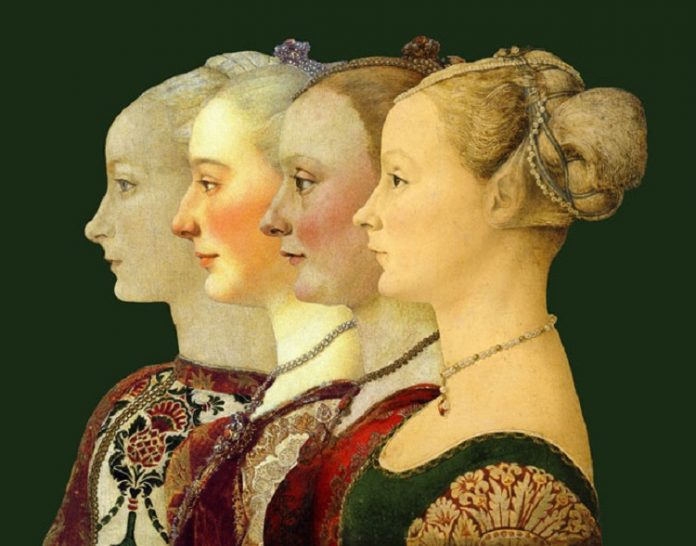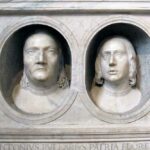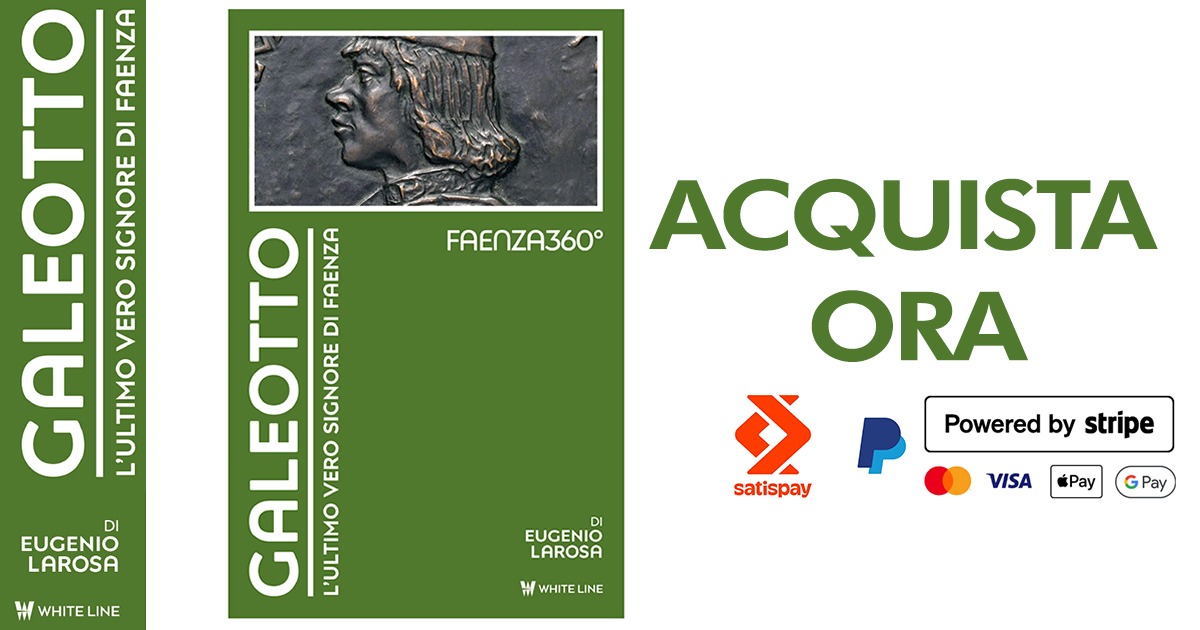
Pollaiolo Young Woman at Poldi Pezzoli Museum – Articolo di Eugenio Larosa
This portrait of a young Florentine woman, seemingly absorbed in her thoughts, was painted in the latter half of the 15th century and is now housed in the Poldi Pezzoli Museum in Milan.
It is widely regarded as one of the most recognisable and celebrated masterpieces of Italian Renaissance art.
In the course of a recent study on 15th-century women’s fashion, I once again found myself captivated by this intriguing painting. This is not my first encounter with it, nor with the four other similar works. However, I regret missing the exhibition “Le dame dei Pollaiolo. Una bottega fiorentina del Rinascimento” at the Poldi Pezzoli Museum, which for the first time brought these paintings together under one roof.
I have since decided to take a more in-depth look into what has so far been a rather superficial study of this piece. In this article, I aim to share the findings of my research and the reflections they have inspired.

As mentioned, this painting belongs to a series of female portraits attributed to the workshop of the Pollaiolo brothers. These works are housed in prestigious collections across the globe, including the Gemäldegalerie in Berlin, the Uffizi Gallery in Florence, and the Metropolitan Museum of Art in New York.
Acquisition
In 1875, the knight Gian Giacomo Poldi Pezzoli acquired the painting, initially believing it to be a work by Piero della Francesca. However, over time, this attribution was contested, and a debate ensued regarding its true authorship, with opinions divided between the two Pollaiolo brothers, Antonio (1431/32–1498) and Piero (1441/42–1485/90).
While the majority view attributes the painting to Piero del Pollaiolo, I personally, though broadly in agreement, lean towards a more inclusive attribution to the Pollaiolo brothers’ workshop as a whole. Such a viewpoint reflects the collaborative nature of Renaissance workshops, where artistic contributions often blended seamlessly.

The Pollaiolo Brothers.
The brothers Antonio and Piero Benci, better known as Del Pollaiolo or Pollaiuolo, were born in the first half of the 15th century in Florence. Their father, a poultry seller at the city’s Mercato Vecchio, gave them the surname that became famous. Like many talented young men of the time, the brothers apprenticed in different art workshops, where they studied painting, sculpture, and goldsmithing.
The Pollaiolo brothers were versatile and accomplished in a variety of disciplines: sculpture, metalwork, engraving, and painting. Each developed distinct artistic preferences, bringing unique qualities to the materials they worked with. Both operated highly regarded workshops in Renaissance Florence and frequently collaborated. Antonio, the elder, was a master of metalwork, engraving, sculpture, and drawing, while Piero, younger by about ten years, focused primarily on painting.
Their close collaboration resulted in many celebrated works, but it also led to some confusion about the authorship of certain pieces, including the portrait of the lady discussed here.
By the early 1470s, the Pollaiolo brothers were in high demand, receiving commissions from prominent figures in both religious and political spheres. One of their notable patrons was Lorenzo the Magnificent.
The focus of the painting.
Around this time, using a mixed technique of tempera and oil on panel, the brothers produced this portrait of a young woman, depicted in profile. Although a later inscription on the back of the panel—removed during a historical restoration—identified her as the wife of the Florentine banker Giovanni de’ Bardi, it is more plausible that she was the betrothed of a member of the noble Romagnol family, the Barbiano of Belgioioso.
The woman’s identity could be further substantiated by tracing the painting’s provenance. The work was documented as part of the collection of Prince Alberico XII Barbiano di Belgioioso d’Este in the early 19th century.
This connection suggests that the young woman depicted was considered an ancestor of the Belgioioso d’Este family, specifically identified as the betrothed of Giovanni II da Barbiano, Count of Cunio.
Painting’s provenance could establish a vital connection between the artwork and the family’s history, revealing not only the identity of the sitter but also the portrait’s genealogical relevance.
Depiction of the young woman suggests she is a potential bride, not only due to her likely age—around fifteen, a common age for marriage at the time—but also through distinctive elements of her attire. The long strands of pearls adorning her neck and hair are particularly noteworthy. Pearls, long associated with purity, were often worn by young women during their engagement, symbolising their commitment to chastity and virtue until marriage. It seems likely, then, that this portrait was commissioned in celebration of the girl’s engagement, serving to highlight both the family’s wealth and social standing, as well as to symbolise the forthcoming union.
The portrait presents the young woman in profile, following a style inspired by classical medallions. Her profile extends beyond the slightly inclined neckline, giving the figure a sense of solidity. She stands out against a soft blue sky, subtly streaked with clouds. A fine, elegant dark line emphasises the contours, allowing the figure to stand out clearly against the background landscape.
At this time, while male portraits were increasingly depicted facing the viewer or in a three-quarter pose, female portraits remained in profile. This difference may have been motivated by notions of modesty, avoiding direct engagement with the viewer’s gaze, and also served to maintain a more abstract and idealised atmosphere.
The Fashion
The figure’s delicacy is accentuated by her long, slender neck and high forehead, highlighted by an elaborate hairstyle and emphasised by her pale, almost translucent complexion. This stylistic choice focuses attention on the young woman’s hair, as the full dress is not visible.
Veils, ribbons adorned with pearls—known as frenelli—and hair so fair it appears bleached (a fashionable trend at the time) recreate the “wasps’ nest” hairstyle (vespaio), popular in the period and much admired by Leon Battista Alberti.
Alberti, in fact, described the ideal of beauty, including the hairstyle, noting that hair should “turn in a circle as though wanting to knot itself, and wave in the air like flames.”(“volgersi in un giro quasi volendo annodarsi, e ondeggianti in aria simile alle fiamme“)
The dress, though only partially visible, exemplifies Renaissance elegance.
It is likely a gamurra or cotta made of fine green fabric, probably velvet, featuring an elegantly fitted neckline adorned with refined geometric embroidery in ochre green.
The wide, puffed sleeves seem to be crafted from a patterned fabric, likely silk brocade, embellished with a white floral motif on a red background, adding an air of opulence and refinement to the garment. The front fastening, executed with great attention to detail, features a white fabric lace threaded through metal loops attached to the bodice.
Beneath the dress, one can catch a glimpse of a delicate undergarment, presumably made from lightweight French linen—a fabric favoured by wealthy Florentine women of the time.
An artistic masterpiece
This painting continues to captivate with its timeless charm, drawing viewers into its world of beauty and intricate detail. Beyond being an artistic masterpiece, it offers a privileged glimpse into the feminine fashion of 15th-century Florence.
Through its elegance and refinement, the painting provides us with a window into the costumes, jewellery, and hairstyles that defined the Florentine elite of the period.
Its enduring beauty, combined with its ability to convey a sense of intimacy and contemplation, makes it a truly remarkable work that continues to fascinate and inspire today’s viewers, just as it did for those in the past.
This work stands as a testament to the extraordinary artistic skill of its creators and serves as a reminder of Italy’s invaluable contribution to the world’s cultural heritage.
Bibliography
A.Wright, “The Pollaiolo Brothers. The arts of Florence and Rome”, New Haven, Londra 2005
J.Lipman, “The Florentine Profile Portrait in the Quattrocento” in The Art Bulletin, Vol.18, No. 1 (Mar., 1936)
A. Tartuferi, “La stanza dei Pollaiolo”, Firenze 2007.
A. Di Lorenzo e A. Galli, “Antonio e Piero del Pollaiolo. Nell’argento e nell’oro, in pittura e nel bronzo…”, Catalogo della Mostra, Skira, Milano 2014.
A. Angelini, “Considerazioni sull’attività giovanile di Antonio Pollaiolo ‘horafo’ e ‘maestro di disegno’”, in ‘Prospettiva’, Firenze Centro Di, n.44, gennaio 1986
Pollaiolo Young Woman at Poldi Pezzoli Museum – Articolo di Eugenio Larosa





















